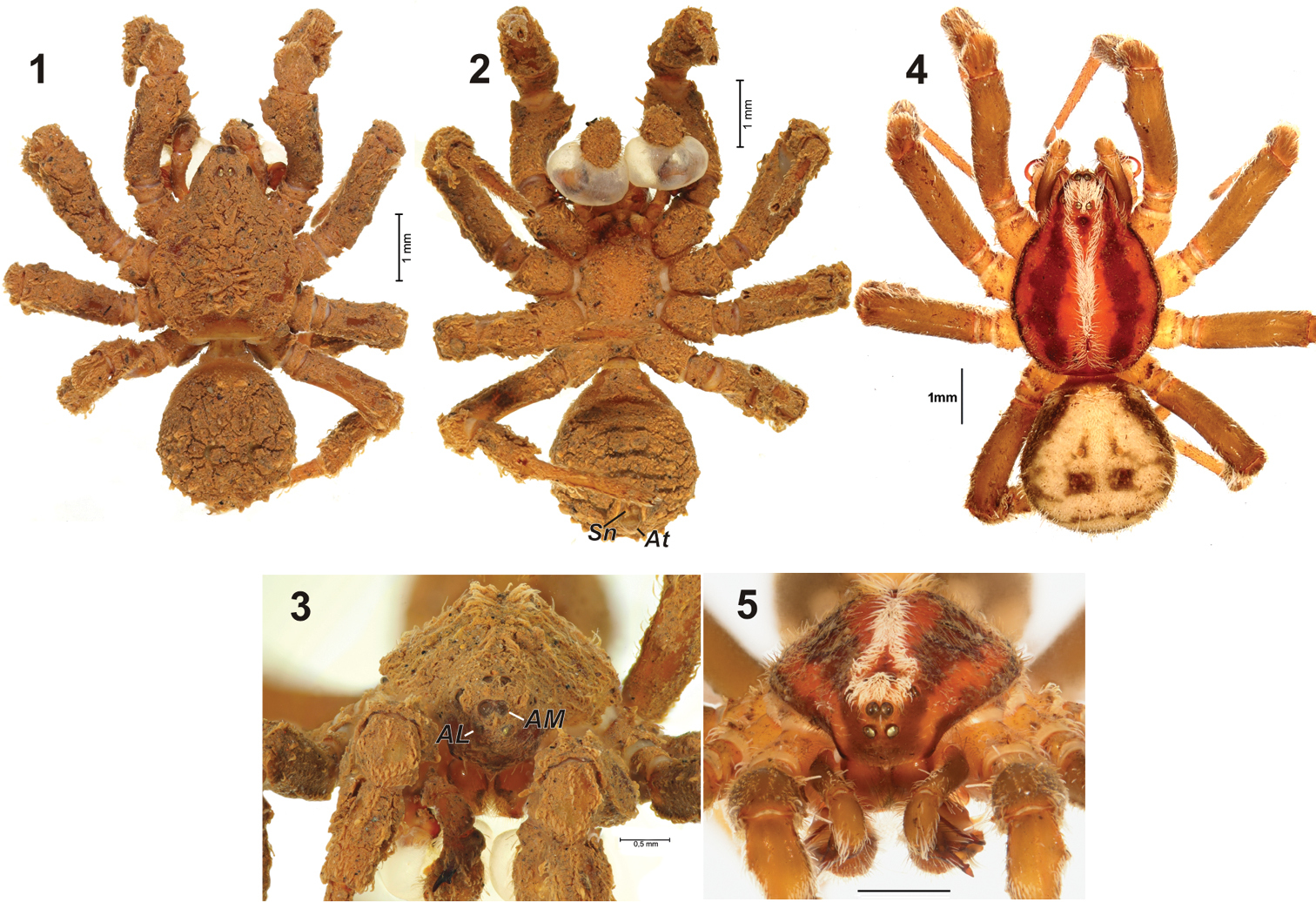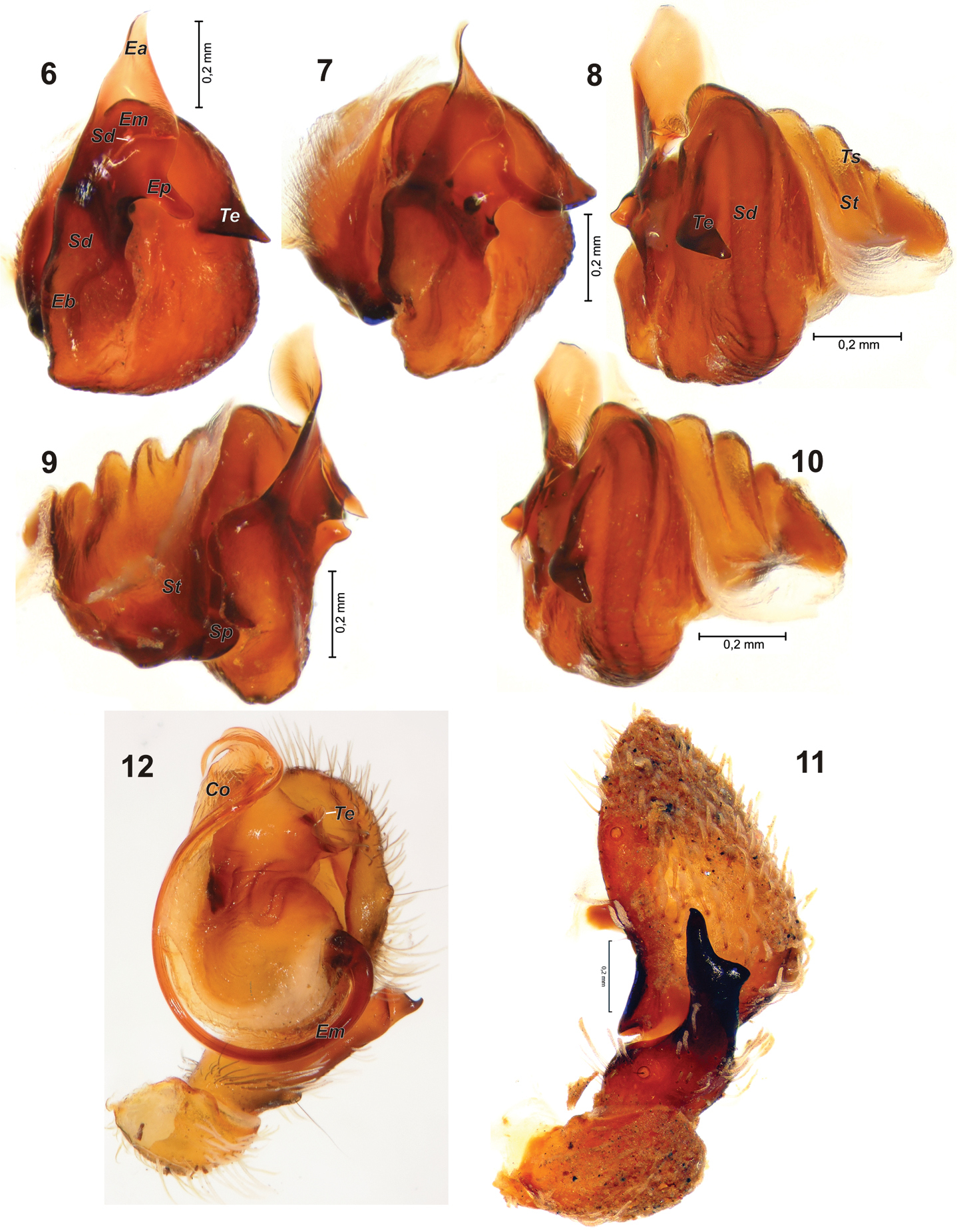






(C) 2013 Yuri M. Marusik. This is an open access article distributed under the terms of the Creative Commons Attribution License 3.0 (CC-BY), which permits unrestricted use, distribution, and reproduction in any medium, provided the original author and source are credited.
For reference, use of the paginated PDF or printed version of this article is recommended.
Citation: Marusik YM, Omelko MM (2013) First description of the male of Cryptothele verrucosa L. Koch, 1872 (Araneae), the type species of the genus. ZooKeys 351: 31–36. doi: 10.3897/zookeys.351.6255
The male of Cryptothele verrucosa L. Koch, 1872, the type species of Cryptothele L. Koch, 1872, known from Fiji and Samoa, is described for the first time. It is compared with the male of C. alluaudi Simon, 1893, the single properly described species of the genus.
Spider, Zodariidae, Cryptothelidae, Fiji
Cryptothele L. Koch, 1872 is a small genus of litter dwelling spiders, the bodies of which are covered with dirt. Up to now eight species and two subspecies are known in the genus. The genus occurs from Seychelles to Fiji and Samoa. Family placement of Cryptothele remains uncertain. Originally the genus was placed in a separate family Cryptothelidae L. Koch, 1872. Soon after,
Of ten species and subspecies described to date, only one species, Cryptothele alluaudi Simon, 1893, is relatively well described and its somatic morphology and the conformation of copulatory organs studied (
Working with collections of the Zoological Museum, University of Turku we found a single male from Fiji identified by Pekka Lehtinen as Cryptothele verrucosa L. Koch, 1872. Cryptothele verrucosa is the type species of the genus and known on the basis of female sex and only from Fiji and Samoa. Since its description it has never been considered in taxonomic papers (cf.
Specimens were photographed using an Olympus Camedia E-520 camera attached to an Olympus SZX16 stereomicroscope. The images were montaged using “CombineZP” image stacking software. Photographs were taken in dishes of different sizes with paraffin in the bottom. Different sized holes were made in the paraffin to keep the specimens in the correct position. The studied material is kept in the Zoological Museum, University of Turku (ZMUT). All measurements are in mm.
http://species-id.net/wiki/Cryptothele_verrucosa
Figs 1–3, 6–11FIJI: 1♂ (ZMUT AA 5.828), Viti Levu, Suva rain forest, 26.05.1973 (J.M. Ackerman).
Cryptothele verrucosa differs from Cryptothele alluaudi, the only properly described species in the genus, by lack of carapace pattern, much more heavy camouflage of dirt that covers whole body, straight row of posterior eyes, anterior lateral eyes spaced by one diameter (1/2 of diameter in Cryptothele alluaudi), shape of tibial apophysis (cf. Figs 11, 12), short and broad embolus with two processes (long and filamentous in Cryptothele alluaudi, Fig. 12).
General appearance of males of Cryptothele verrucosa (1–3) and Cryptothele alluaudi (4–5). 1, 4 dorsal 2 ventral 3, 5 frontal 4–5 after
Male palp of Cryptothele verrucosa (6–11) and Cryptothele alluaudi (12). 6 bulbus, ventral 7 bulbus, ventro-prolateral 8, 10 bulbus, retrolateral 9 bulbus, prolateral 11 palp with removed bulbus, retrolateral 12 palp, ventral (after
Measurements. Total length 5.5, carapace 3.0 long, 2.28 wide. AME 0.14, AME-AME 0.15. Position of metatarsal trichobothria IV 0.9.
Whole body, including sternum and venter of abdomen covered by comouflaging dirt (Figs 1–2). Carapace brown, without pattern, with two rows of hairs aside of median line, these rows are visible after removing the comouflaging dirt. AME spaced by one diameter (Fig. 3), anterior eyes form inverted trapezium (ALE row wider than AME row), posterior eye row almost straight, cephalic area with pit behind posterior median eyes. Leg subeaqual in length, formula 1423. Legs heavily built, with thick femur–tibia and twice as thin metatasrus–tarsus, border between tarsus and metatarsus poorly visible, metatarsi with terminal trichobothria.
Length of legs and leg joints.
Abdomen oval, with two spinnerets (Sn) about the size of anal tubercle (At).
Palp as shown in Figs 6–11. The single specimen examined has both palps expanded. Tibia (Fig. 11) with long retrolateral apophysis tapering in terminal 1/3, dorsal side of apophysis with shallow blunt outgrowth, retrolateral side of tibia with trichobothrium in proximal part; cymbium oval, with trichobothrium on retrolateral side. Subtegulum (St) (Figs 8–10) large (as long as tegulum in lateral view), cone-shaped with three threads (Ts); prolaterally with process (Sp) directed to notch of embolic base. Tegulum nearly oval with triangle extesion (Te) in terminal part (Figs 6, 8, 10). Embolus (Em) broad, longer than tegulum, heavily built in the base (Eb), terminal part lamellated with two processes: digitiform posterior process (Ep) and triangle shape terminal process (Ea), seminal duct (Sd) broad and heavily sclerotised in the base of embolus, and very fine in lamellar part of embolus.
Thanks to the discovery of the male of Cryptothele verrucosa (the easternmost species of the genus) it has became possible to compare it with the westernmost species, Cryptothele alluaudi. General appearance of the two species is rather similar (Figs 1–5). They differ in amount of camouflage cover which is almost absent in Cryptothele alluaudi, but Cryptothele verrucosa is covered heavily on dorsal and ventral sides. Both male and female of Cryptothele alluaudi have a distinct pattern on the carapace. Such a pattern is absent in the studied male of Cryptothele verrucosa (we have removed the camouflage cover); it is also absent in the conspecific female, judging from L. Koch’s description. Male of Cryptothele alluaudi has relatively longer and thinner legs (cf. Figs 1 and 4) and less spaced anterior lateral eyes (Figs 3 and 5). The posterior eye row is straight in Cryptothele verrucosa (Fig. 1) and recurved in Cryptothele alluaudi (Fig. 4). Male palps in two species are strikingly different. Cryptothele alluaudi has a long filamentous spiraled embolus and conductor (Co) (Fig. 12). In Cryptothele verrucosa the embolus is flat and broad. Extension of tegulum in Cryptothele alluaudi is weakly sclerotized and has subparallel margins, while in Cryptothele verrucosa it is triangle–shaped and strongly sclerotized.
In the collection of the Zoological Museum, University of Turku we had the opportunity to examine males of two unidentified species of Cryptothele, one from Thailand (which seems new to science) and another from Indonesia (probably Cryptothele sundaica Thorell, 1890). Males of both species have conformation of the palp similar to that in Cryptothele alluaudi (a thin and long embolus, a well developed conductor, etc.). This may indicate that Cryptothele alluaudi, Cryptothele sundaica and the mentioned undescribed species most likely are not congeneric with Cryptothele verrucosa and the genus could be split in the future into two separate genera.
Cryptothele sp. (presumably new) 1♂ (ZMUT: AA 5.812), Thailand, Chanthaburi Pr., Kho Yai N.P., Wang Chum Pee, rain forest, 27.10–22.11.1976 (P.Lehtinen) covered with dirt, even cymbium, but RTA like in Cryptothele alluaudi, embolus and conductor long.
Cryptothele sundaica?: 2♂ 1♀ (ZMUT: AA 5.806), Indonesia, Sumatera Barat, Paykumbuh d., Lubu Bangku, low jungle, 7.12.1980 (P.T.Lehtinen).
We wish to thank Seppo Koponen who arranged our stay in Turku and allowed the use of local facilities (digital camera attached to microscope). We also thank anonymous reviewers and Shuqiang Li for helpful comments on a draft of the manuscript. English of the final draft was kindly checked and corrected by Donald Buckle (Saskatoon, Canada). This work was supported in part by the Russian Foundation for Basic Research (grants № 11–04–01716 and 12–04–01548) and Far Eastern Federal University (Vladivostok).

